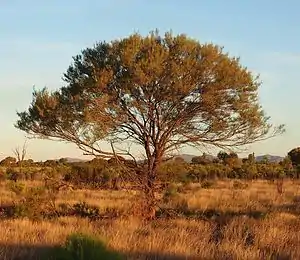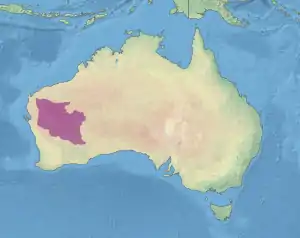Western Australian mulga shrublands
The Western Australian Mulga shrublands is a deserts and xeric shrublands ecoregion of inland Western Australia.[2] It is one of Australia's two mulga ecoregions, characterized by dry woodlands of mulga trees (Acacia aneura and related species) interspersed with areas of grassland and scrub.
| Western Australian Mulga shrublands | |
|---|---|
 Mulga tree (Acacia aneura) in mulga shrubland. | |
 Location of the Western Australian Mulga shrublands ecoregion. | |
| Ecology | |
| Realm | Australasian |
| Biome | deserts and xeric shrublands |
| Borders | |
| Geography | |
| Area | 461,958 km2 (178,363 sq mi) |
| Country | Australia |
| State | Western Australia |
| Conservation | |
| Conservation status | Vulnerable |
| Protected | 14,900 km² (3%)[1] |
Location and description
This is a hot, dry area with little rainfall.
The region consists of the Gascoyne and Murchison bioregions of the Interim Biogeographic Regionalisation for Australia (IBRA).[3][4]


Flora and fauna
The predominant vegetation is mulga trees, a type of acacia adapted to the hot, dry climate by means of long tap roots. In some areas the mulga trees are surrounded by Eriachne grassland.
Wildlife of the region includes birds such as emus, Australian bustards and honeyeaters.
Most of the area is uninhabited but there is some mining activity and some sheep grazing, both of which cause damage to native habitats.
Protected areas
Protected areas in the ecoregion include Collier Range National Park.
External links
- "Western Australian Mulga shrublands". Terrestrial Ecoregions. World Wildlife Fund.
References
- Eric Dinerstein, David Olson, et al. (2017). An Ecoregion-Based Approach to Protecting Half the Terrestrial Realm, BioScience, Volume 67, Issue 6, June 2017, Pages 534–545; Supplemental material 2 table S1b.
- "Western Australian Mulga shrublands". Terrestrial Ecoregions. World Wildlife Fund.
- Environment Australia. "Revision of the Interim Biogeographic Regionalisation for Australia (IBRA) and Development of Version 5.1 - Summary Report". Department of the Environment and Water Resources, Australian Government. Archived from the original on 2006-09-05. Retrieved 2007-01-31. Cite journal requires
|journal=(help) - IBRA Version 6.1 data